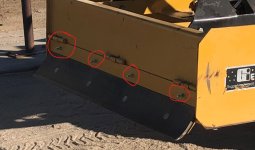One of the biggest challenges I have is figuring out what size of top link to use. With my disc (two rows of eight blades) I need a long top link so it will not dig in. With the box blade I use a smaller top link but even then it is not short enough for me to adjust so the cutter will dig in to pick up dirt. I use the longer top link with the mud plow since I can't let the plow go too deep or the tractor stops dead. My question: What is the correct length of top link to use? How do you determine the correct length? Thanks!
I bought my box blade mostly for gravel road maintenance. I have a steep driveway and heavy rains create ruts. When I got the blade and set it up fairly neutral it worked, but not great. Shortening the top link dug deeper, but I didn't always want to dig deep. I wasted a lot of time adjusting the top link for simple jobs that should've only taken 15 to 30 minutes. When I saw "Dave knows how" you tube video about the box blade and the "angle of the dangle" I knew I had to get a hydraulic top link. Having the ability to go from digging to smoothing instantly from the drivers seat made me look semi-competent

